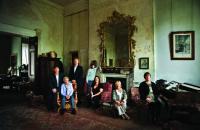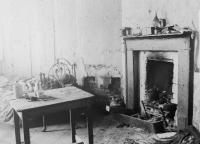The Tenements
Published in 18th-19th Century Social Perspectives, 18th–19th - Century History, 20th Century Social Perspectives, 20th-century / Contemporary History, General, Issue 5 (Sept/Oct 2011), Reviews, Volume 19
Bryan Murray, a descendant of tenement-dwellers who got his first break in, appropriately, RTÉ’s adaptation of Strumpet City, presented the series with great aplomb. (Big Mountain Productions)
The Tenements was an ambitious four-part series about Dublin’s notorious inner-city slums. Alongside the legacy of the Vikings and the impressive edifices of Georgian Dublin, the existence of the tenements is one of the best-known aspects of Dublin’s history, famously depicted in Seán O’Casey’s trilogy and James Plunkett’s Strumpet City. But this heritage was perhaps not to be advertised with pride, nor dwelt on with nostalgia. The cold reality is that at their peak prior to the First World War, with approximately 20,000 families (perhaps a third of the whole) living in single rooms, Dublin’s tenements contained some of the worst urban poverty to be found in western Europe. Given that so many of Dublin’s natives will be descended from the tenements, this excellent series would naturally have a broad appeal in the capital. Presented with great aplomb by the actor Bryan Murray (a descendant of tenement-dwellers who got his first break in, appropriately, RTÉ’s adaptation of Strumpet City), it provided a rare panoramic view of the squalid reality of life in Dublin’s infamous slums.The tenement problem that emerged in the late nineteenth century was a product of decline. The eighteenth-century Irish parliament, while an exclusively Protestant institution that offered no representation to the Catholic majority (and, lest we forget, Dissenters), was ended by the 1800 Act of Union. The removal of the parliamentarians, who would now leapfrog Dublin en route to Westminster, had two immediate effects. The first was that the elegant townhouses built as the urban residences of the ‘Ascendancy’ became redundant (a century later many would be tenements); the second was that the service industries and consumer culture that had developed around the parliament were stripped away. This social and economic hammer blow, when combined with newly established absentee governance from London, precipitated Dublin’s long decline from second city of the empire to provincial centre within the UK. And within the UK, Dublin’s primary function was as a transit point for the export of food and people, and the importation of British goods: a perpetual motion driven by the imperatives of Britain’s industrial centres, and which also starved Dublin of the wherewithal to develop its own manufacturing base. In the mid-nineteenth century this economic stagnation was accompanied by one of the most significant social developments in the city’s history, as the emergent Catholic (and remaining Protestant) middle classes abandoned the city between the canals and relocated to new townships such as Clontarf and Rathmines. In the vacuum left behind, the tenements flourished.

Members of the Winston family (L–R: John, Annie, presenter Bryan Murray, Don Elliot Baker, Orla Doyle, Margaret and Cathy) who opted to spend an exceptionally cold weekend in their old home at 7 Henrietta Street, which was built in the 1730s and had 104 inhabitants in 1911! (Big Mountain Productions)
The series began with an overview of the tenements and their development before focusing on those who dwelt in them. The second episode dealt with life inside the actual buildings. The squalor they contained was staggering: poverty, malnutrition, rampant disease, cramped quarters, a lack of hygiene, and an infant mortality rate that far outstripped that of London. The poor of Dublin were visibly malnourished to observers, and alongside physical poverty were shocking indications of the psychological problems it engendered. The slum-dwellers had little opportunity to pull themselves out of such poverty, and the third episode dealt with how they engaged with society at large. The absence of major industries in Dublin meant that such work as was available to men was casual and uncertain. Women often had to step into the breach: hence the development of street trading, and also the horrific reality of prostitution, which reached its notorious pinnacle in ‘Monto’. Interwoven with the testimonies of historians and tenement-dwellers was the experience of the Winston family, who opted to spend an exceptionally cold weekend in their old home at 7 Henrietta Street, which was built in the 1730s and had 104 inhabitants in 1911! Some of the Winstons had been living there as late as 1972, and in the course of the series they returned, along with some younger members who had never experienced tenement life. It was a touching human thread that ran throughout the series; none of the Winstons left Henrietta Street with any sense of nostalgia for the hardship that they left behind.

Interior of a tenement in the Coombe, 1913. The squalor they contained was staggering: poverty, malnutrition, rampant disease, cramped quarters, a lack of hygiene, and an infant mortality rate that far outstripped that of London. (Royal Society of Antiquaries of Ireland)
It cannot be stated strongly enough that such dreadful conditions were tolerated by the powers that be, and the series ended with a hard-hitting exposition of this outrageous reality. Pockets of slum poverty would remain in existence until the end of the 1970s, and any lingering nostalgia for the lost promise of a Home Rule Ireland should be tempered by noting how the existence of such truly horrific conditions was not seen as problematic by either the Home Rulers or their eventual successors. Nor did the Catholic hierarchy evince much interest: families might write to the church beseeching help, sometimes even for so basic a necessity as clothes to wear, and might threaten that if their church were to fail them the reality of their lives would force them to turn to its Protestant counterparts. The overwhelmingly rural ethos of the new independent state saw inner-city poverty continually ignored. In 1913 the collapse of houses on Church Street killed six people and precipitated an inquiry that would reveal the extent to which respectable city councillors profited from the ownership of properties that their own officials had condemned as unfit for human habitation. A planned programme of slum clearance was derailed by the outbreak of the First World War, and it would take the deaths of two people in the collapse of a house on Fenian Street in 1963 to bring the inner-city housing problem to the fore once again. In 50 years the ruling élites of Ireland—of all parties—did nothing to deal with the squalor in their midst, a fact that highlights the endurance of Ireland’s almost Darwinian class structure. The poor of Dublin’s inner city were subjected to the most brutal and humiliating treatment from teachers, from clerics and from the agents of the state. Given the continued existence of such class prejudice in Ireland, along with the prominence still accorded to property speculation as an economic activity, it was striking to see members of the Winston family refuse to rule out the possibility that Ireland has not seen the last of its slums. What may the future hold? This was an excellent series. An engrossing and powerful mixture of orthodox documentary, oral history, reality TV and Who do you think you are?, The Tenements was easily one of the best Irish documentary series to appear in recent years. HI


















